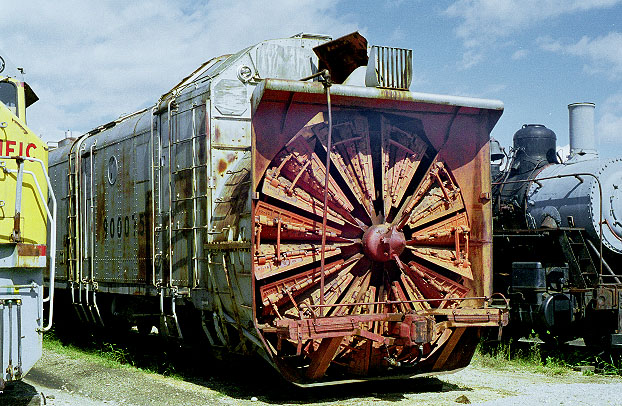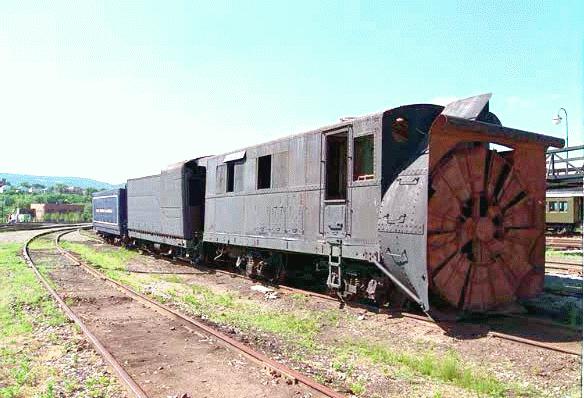Install the app
How to install the app on iOS
Follow along with the video below to see how to install our site as a web app on your home screen.
Note: This feature may not be available in some browsers.
You are using an out of date browser. It may not display this or other websites correctly.
You should upgrade or use an alternative browser.
You should upgrade or use an alternative browser.
Some info about a really big locomotive...
- Thread starter AndreaLuigi
- Start date
johnchisem
Mr Grumpy
He went to Specsavers.
John
John
AndreaLuigi
New member
Look at one of the tender... the one in front, I presume.How can the driver see?
As for that steam snowplow. Yup that's insanity. However it very might have well existed.



Yup, I'd say they existed.
Spawn_of_Chaos97
Trainz for Everyone!
Yeah, there's a cab on the front of the front tender (watertank?) of the Bigger Boy.
Oh, just in case anyone's wondering, the Bigger Boy is a 4-8-8-4-8-8-4-8-8-4
Oh, just in case anyone's wondering, the Bigger Boy is a 4-8-8-4-8-8-4-8-8-4
Norfolkwesternman
I like Submarines&Trainz
i askd bill and cory and they said it was an experimental,
Spawn_of_Chaos97
Trainz for Everyone!
They've got you on their leash then. The Huge Boy never really existed; for that matter, neither did the Bigger Boy I posted. However, TrainzItalia has created a Huge Boy for Trainz and I would love to see a Bigger Boy in Trainz...too bad the Big Boy tender uses like about 7 bogies!
Damn centipede tender...
Damn centipede tender...
So what would you call the Bigger Boy, a Mallet-Garratt?
Something like that: an articulated Garratt. True "Mallet" locomotive are articulated but with double expansion engines: N&W Y-6b was a true Mallet, as it had a set of high-pressure cylinders and steam coming out from these fed the low pressure cylinders. Challengers & Big Boys were not Mallets, since all cylinders were fed with steam at the same pressure.
Double expansion provides higher efficiency, but the engine is more complicated to build, drive and mantain. As far as I know, this system had its moment of glory in early 1900s, then most railroads worldwide preferred using supeheating, which improved performance without the complication of double expansion. The only companies that continued to use double expansion locomotives were the N&W and the French, both of them building some of the finest machines ever seen.
P.S. Unlike the Huge Boy which were [would have been? :hehe: ] reasonable freight engines, the Bigger Boywould have been great as a yard switcher, as feeding 6 pairs of cylinders with the Big Boy boiler would have been very difficult...
AndreaLuigi
New member
So what would you call the Bigger Boy, a Mallet-Garratt?
Claude
How about Double Boy?
http://private.trainzitalia.com/alm/davinci/ital/seiten/seiten/usa/fair.html
Last edited:
If you are trying to imply Mallets were no longer used after the early 1900s then sorry, but you are just plain wrong. The PKJA (Indonesian State Railways) and Insular Lumber in the Philippines were using these type of engine at least into the late 1970s.Double expansion provides higher efficiency, but the engine is more complicated to build, drive and mantain. As far as I know, this system had its moment of glory in early 1900s, then most railroads worldwide preferred using supeheating, which improved performance without the complication of double expansion. The only companies that continued to use double expansion locomotives were the N&W and the French, both of them building some of the finest machines ever seen.
Dave Bird
WileeCoyote
Eatibus Almost Anythingus
The HSB (Harzer Schmalspurbahn) still has some in service, most of them having been built during the turn of the century, of course the only reason for them remaining in service is 1. There are almost no 1000MM gauge mallets left in Germany that are even operational and 2. During the Cold War the DR of the GDR did not have enough money to justify replacing them.
WileeCoyote
WileeCoyote
If you are trying to imply Mallets were no longer used after the early 1900s then sorry, but you are just plain wrong. The PKJA (Indonesian State Railways) and Insular Lumber in the Philippines were using these type of engine at least into the late 1970s.
Eric, thanks for providing me with a bit of railway history I didn't know. I wrote "most railroads worldwide preferred using supeheating, which improved performance without the complication of double expansion."
Even if i didn't know of Indonesian and Philippine Mallets, I am aware that Mallets are still in use. In Eritrea, for example, some R.440-class B'B' locomotives still haul trains at age 80, and I imagine (I hope
In the US, however, Mallets were no more built after 1920s, except for those of N&W. In Europe, they were used only in very particular situations, mostly on very steep grades, and in fact most of them are tank engines serving on mountain railroads. As far as I know no railway company in Europe used Mallets for long-distance main line service.
Regards
AndreaLuigi
New member
Double expansion provides higher efficiency, but the engine is more complicated to build, drive and mantain. As far as I know, this system had its moment of glory in early 1900s, then most railroads worldwide preferred using supeheating, which improved performance without the complication of double expansion. The only companies that continued to use double expansion locomotives were the N&W and the French, both of them building some of the finest machines ever seen.
Double expansion has been one of the most controversed argument in the history of steam locomotives.
It is very interesting to note that after a first period of diffusion, double expansion went back in the interest of steamer developer until the end of the '30 where a new tendency, mostly supported by Andrè Chapelon in France, developed the double expansion concept to his limit increasing the efficency of steam engines at a level never reached before.
To remember are not only a few prototypes, but a large amount of double expansion locomotives that reached functionally the end of the steam era: Super Pacific 231 and 241 with more the 3000 hp in France and in North America the famous and unforgettable Y6b of N&W, the last big steamer in service in the USA, a "real" Mallet at the state of the arts of the 40'.
To remember are experiments with triple expansions based on middle pressure boilers and many systems to switch between single and double expansion during the locomotive's service.
Norfolkwesternman
I like Submarines&Trainz
well Bill worked on the Union pacific when the big boy's came out and even though thhis picture is fake the union pacific's website has a record of one built. becaue the 8000's were the FEF's. the huge boy isn't its name. its called the yellowstone locomotive and it couldn't handle turns well so it ran from cheyeanne to somware in the dakota's. there is a site howver i don't know hte name but it has the record of the yellowstone. it was built but then scrapped very quickly because of fuel and running costs.
ps amtrak had a steam locomotive with steam turbines in the tender. it didn't run to well and they scrapped it after the huge boy
ps amtrak had a steam locomotive with steam turbines in the tender. it didn't run to well and they scrapped it after the huge boy
AndreaLuigi
New member
I agree with Norfolkwesterman on all but a small detail:
The FEF has been the 800 class, not 8000. The Huge Boy had a UP classification as FEEEF...
The FEF has been the 800 class, not 8000. The Huge Boy had a UP classification as FEEEF...
Spawn_of_Chaos97
Trainz for Everyone!
Yellowstones were I believe 2-8-8-2's, not 4-8-8-8-4's!
2-8-8-4. There's one on You-tube, but I can't go there today because my net connection is a bit fussy.Yellowstones were I believe 2-8-8-2's, not 4-8-8-8-4's!
Similar threads
- Replies
- 0
- Views
- 296
- Replies
- 3
- Views
- 500
- Replies
- 3
- Views
- 807
- Replies
- 166
- Views
- 13K
